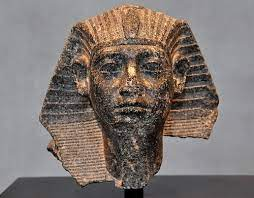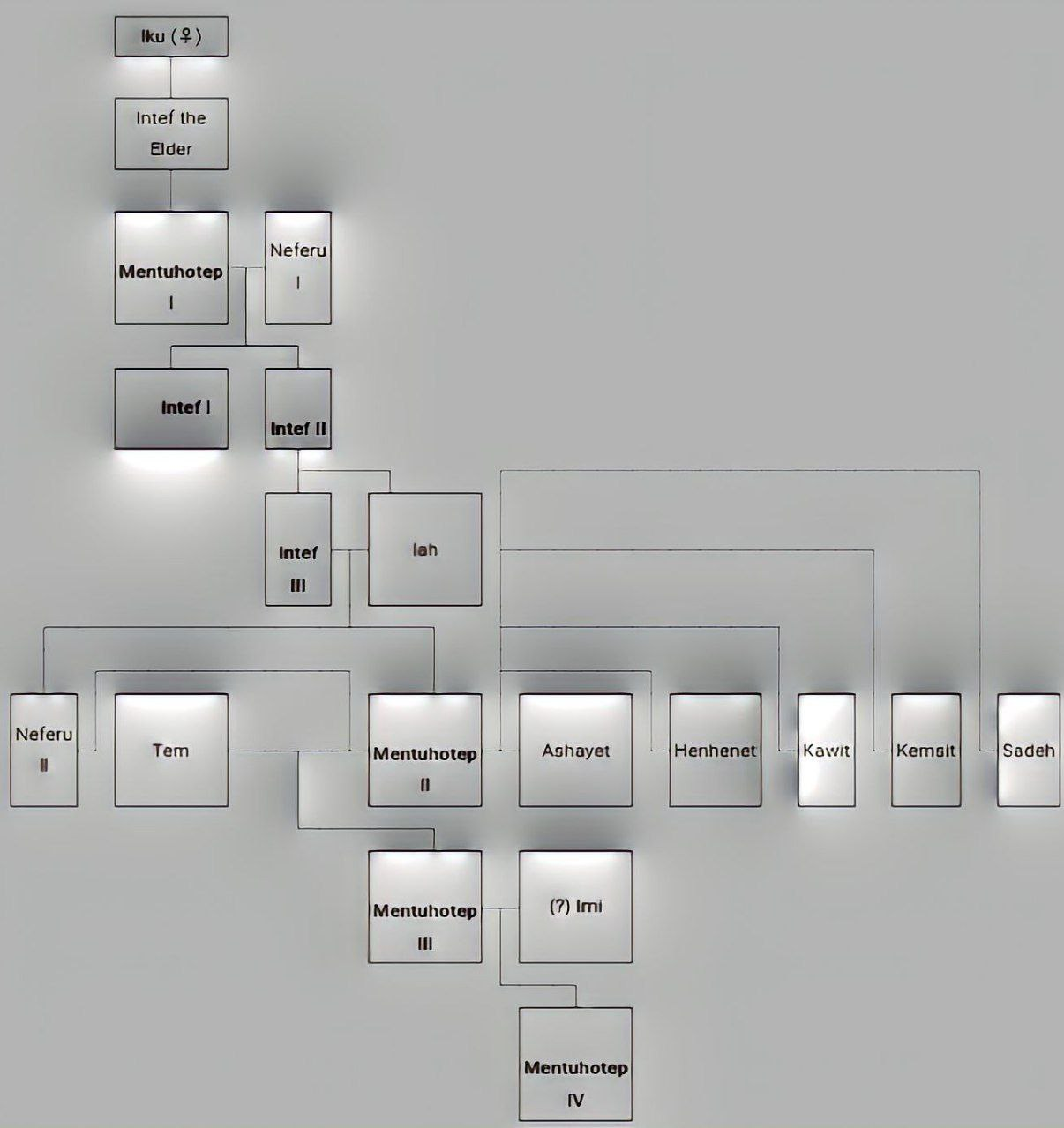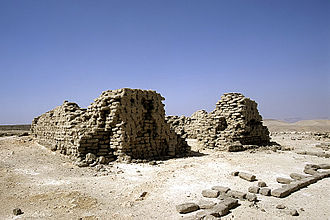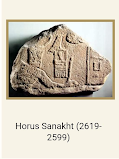The Age of the Pyramids refers to the fact that the Fourth Dynasty was the time when most of the well-known pyramids were built, which include those at Giza. King Sneferu was the first king to express an interest in funerary rites and tombs, which led him to the planning of the largest pyramid at Egypt. His first pyramids were called the Bent Pyramid and Red Pyramid. The "Age of the Pyramids" was not just about the building of large and easily recognizable structures, but also a change in funerary practices and rituals. This includes the burying of elites in large structures and the use of extensive mummification.
 |
| Family tree of The 4th Dynasty |
The 4th Dynasty of ancient Egypt is characterized as a "golden age" of the Old Kingdom of Egypt. Dynasty IV lasted from c. 2613 to 2494 BC. It was a time of peace and prosperity as well as one during which trade with other countries is documented.
The 4th Dynasty heralded the height of the pyramid-building age. The relative peace of the 3rd Dynasty allowed the Dynasty IV rulers the leisure to explore more artistic and cultural pursuits. King Sneferu's building experiments led to the evolution from the mastaba-styled step pyramids to the smooth sided “true” pyramids, such as those on the Giza Plateau. No other period in Egypt's history equaled Dynasty IV's architectural accomplishments
The 4th Dynasty was the second of four dynasties that made up the "Old Kingdom". King Sneferu, the first king of the 4th Dynasty, held territory from ancient Libya in the west to the Sinai Peninsula in the east, to Nubia in the south. It was a successful period and this era is known for its advancement and concentrated government, as seen in the organized building of pyramids and other monuments.
- Period: Old Kingdom
- From: 2575 BC To: 2465 BC
- 4th Dynasty Kings
- Snefru (2575-2551)
- Kheops (2551-2528)
- Djedefre (2528-2518)
- Khefren (2518-2492)
- Bakare (2492-2490)
- Menkaure (2490-2472)
- Shepseskaf (2472-2467)
- Religious changes
The 4th Dynasty is where we truly see a shift in religious practices where worship of the Sun was commonplace. The Cult of Ra grew in size, going back to the fact that Djedefre's tomb was built closer to the center of worship in what the Ancient Greeks called Heliopolis. It was a delta city near contemporary Cairo that had been occupied since the predynastic times, whose ancient Egyptian name was Iwnw or Iunu and meant the pillars.
During the era when centralization of the nation's material, organic, and human resources began to develop, a relationship of the king to the deities became unchallenged and kings began carving their names into statues and monuments that previously had been reserved for deities. This speaks to a type of god complex on part of the kings. Khafre's famous statue, where a falcon was incorporated into his headgear, equated the king to the god Horus.
This fact, however, caused controversy. It was pitting Khafre's allegiance to Horus against the growing Cult of Ra, not far away in Helipolis. Kings no longer associated pyramids with the afterlife. The afterlife was once believed to be a divine kingdom that was represented as a type of idealistic heaven where only kings and pure hearts could go. Instead, the 4th Dynasty represented a change in this idea, formulated the notion that the afterlife was a familiar place, taking the semblance of Earth. Religious rituals were notoriously conservative, from what historians know, and there is much to be desired from current known records.
- Changing customs drove architectural changes:
Relief of Nofer and his Wife, detail. From Giza, tomb G2110, Dynasty 4, 2575–2465 BC.
The Old Kingdom saw a rise in the preservation of the deceased, making the preparation of bodies much more complex. The position of embalmer was created, and their jobs were solely to prepare a corpse in private.
There were three ways to mummify a body: Stucco: the body would be wrapped in fine linen and then covered in stucco plaster, the features of the body (including the face) were remodeled in the plaster; Linen: the body would be wrapped in linen, which was sometimes treated with natron (a mixture of multiple sodium carbonates. and the linens would be treated with resin so that the features of the body could be modeled; and Defleshing: removing all flesh and wrapping the bones in linens. Generally, organs were removed which were then put into jars that would accompany the body in the tomb, and the inside of the body flushed out.
Tombs in the 4th Dynasty changed drastically. "Unimpressive" graves did not satisfy the elites, meaning they would settle for smaller structures if the interior was decorated. Hieroglyphic writings were important to elites because, one, it was a lavish display of wealth and, two, it guided their souls to the afterlife. The 4th Dynasty, however, did not have these writings. Instead, the tomb was deeper and super-structures were larger. After the Giza pyramid complex, later generations of tombs were more reasonably sized. After the Middle Kingdom, royals abandoned pyramids; they preferred graves that were carved into living rock of the Upper Egyptian mountains.
Sneferu, lauded as "Bringer of Beauty", "Master of All Justice", and "Ruler of Lower and Upper Nile", was the first pharaoh of the fourth dynasty. He descended from a family in Middle Egypt that lived near Hermopolis, and most likely ascended to the throne by marrying a royal heiress. There is still debate as to who his father was, with the credit often being given to Huni, but this cannot be confirmed due to the break in dynasties. His mother, Meresankh I was either a lesser wife or concubine of Huni.
Egypt in the Third Millennium BC was, by all accounts, a land of peace and plenty. Elites commonly ate fattened ducks and geese, and they wore fine white linens.
Until his reign, Egyptian kings were thought to be worldly incarnations of Horus, obtaining total deification exclusively in death. Sneferu was the first king to proclaim that he was the embodiment of Ra, another sun deity. Khufu would pursue his father's path, taking the name Son of the Sun God.
 |
| Cartouche name Sneferu in the Abydos King List |
On the whole, Egypt was ruled by two centers of power—legal authority and traditional authority. Legal authority constituted governing by the king, not over the people directly, but via viziers and nomarchs. Traditional authority was derived from the concept that the deities gave a king the divine right to rule as he pleased. At its heart, the 4th Dynasty Egyptian government became organized so that only the king could direct traditional authority.
 |
| The Bent Pyramid |
The Bent Pyramid was Sneferu's first attempt at building a perfect structure, but it slopes and eventually bends to a lower angle, giving the structure a squished look. His Red Pyramid is widely considered the first true pyramid and earned its name from the reddish tint in the limestone used. The Red Pyramid was considered the first pyramid, approximately 150 years after the structures built by King Djoser. The Red Pyramid was the first to be given a solid foundation so that it was stable enough for a taller building. He is also said to be responsible for a series of pyramids built in Seila. He commissioned a total of three pyramids, but there are records that point to a fourth. Although he did not construct any of the pyramids at Giza, he is known as the king who moved the most stone and brick. A lot of Sneferu's political expeditions were to other countries to secure two things: a substantial labor force and access to a large store of materials. He traveled to Nubia and Libya for these things. His incursions in these areas allowed Sneferu to secure a large labor force, so large, in fact, that it caused huge devastation to the raided countries. He also needed cattle and other food sources to provide to the people building his pyramids.
 |
| Meidum Pyramid |
 |
| Red Pyramid at Dashur |
By the end of his military efforts, he managed to capture 11,000 prisoners and 13,100 head of cattle.
- 2- Khufu:
King Khufu built The Great Pyramid of Giza
 |
| King Khufu |
Painted limestone Sphinx of Hetepheres II, possibly the first depiction of a sphinx, she was one of the longest lived members of the 4th dynasty royal family, a daughter of Khufu, she was the wife of, and lived into the reign of Shepseskaf
Djedefre is credited by historians with a reign of eight years. Not much is known of Djedefre, including his inconclusive lineage. It is possible that he is Khufu's son or that he was Khufu's brother. It is widely suggested that he is the son of a lesser queen who murdered the rightful heir to the throne and Djedefre's half brother, the crown prince Kawab. Djedefre chose to build his pyramid several kilometers north of Giza, creating speculation that there was a family feud that caused Djedefre to want to be far away from Khufu's tomb. A more favorable conclusion was that Djedefre chose to be buried closer to Iunu, the center of the cult of Ra. His pyramid also features a statue of his wife, Hetepheres II, in the form of a sphinx. She was a daughter of Khufu and had been the wife of Kawab. It is sometimes suggested that this was the first true sphinx, although there is debate about the sphinx at Giza that was credited to Khafre. She became the longest living royal member of the dynasty, living into the reign of Shepseskaf.
 |
| Cartouche of Djedefre |
 |
| So little remains of the pyramid, that it was assumed it was left unfinished. |
 |
| A view on the remains of the mortuary temple, with two of the Giza pyramids in the background. |
- 4- Khafre:
 |
| King Khafre with Horus |
 |
| statue King Khafre |
 |
| Khefren's pyramid at Giza, with the Great Sphinx in the foreground. |
Like many kings in this dynasty, the length of Menkaure's reign is uncertain, being projected for more than 63 years but it can certainly be an exaggeration. Menkaure succeeded his father, King Khafre. His pyramid is the third and smallest of those at Giza pyramid complex and is known as Netjer-er-Menkaure, which translates into "Menkaure is Divine". There was a sarcophagus found within the pyramid, that is approximately eight feet in length and three feet in height, made of basalt. Like many of the previous pyramids, Menkaure's was not inscribed, the interior having no record keeping of any kind.
 |
| Menkaure Pyramid |
 |
| Valley Temple of Menkaure |
Shepseskaf is generally accepted as the last king of the 4th Dynasty, succeeding Menkaure. There is no conclusive evidence of who his mother is, though it is believed that he was the son of a minor queen. Who his wife was also is unknown. Shepseskaf broke the chain of pyramid building by the previous five kings. Instead of a triangular pyramid, he chose to construct a rectangular block, commonly known as the Mastabat al-Fir’aun ("Pharaoh's Bench"). In like fashion, however, little script was found inside his tomb and he was buried in very simple terms.
 |
| The oddly shaped tomb of Shepseskaf at Saqqara. |











































